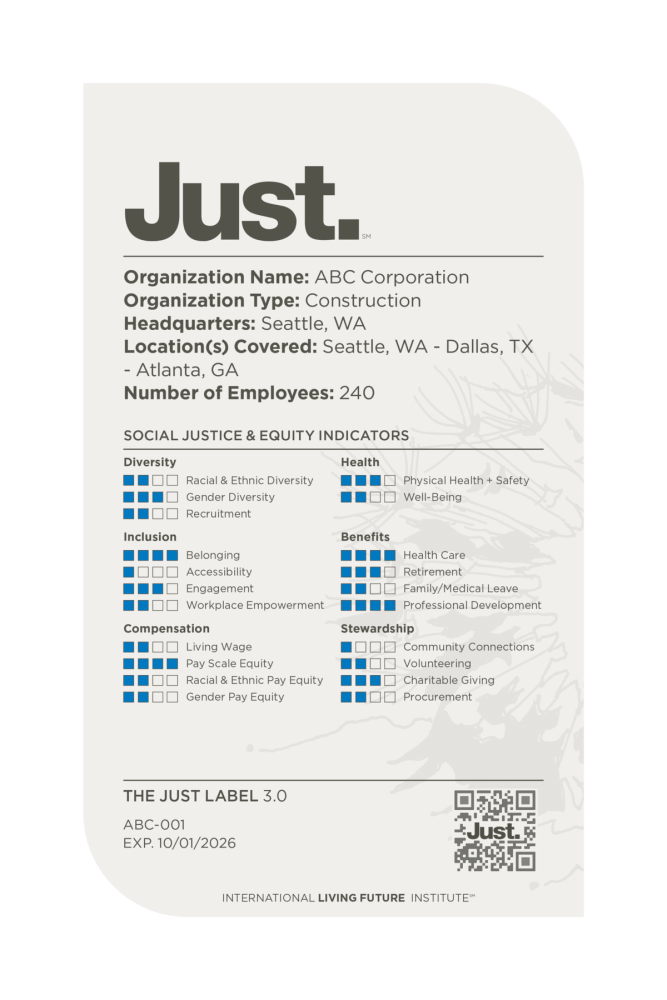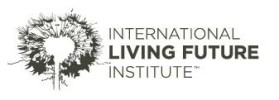CATEGORIES + INDICATORS
The Just program is organized around 21 social justice and equity Indicators that are housed within six Categories: Diversity, Inclusion, Compensation, Health, Benefits, and Stewardship. Each Indicator outlines measurable accountabilities that are recognized at four levels of performance and highlighted on the Just label. The label allows for “at a glance” information about the organization’s progress across the Categories and Indicators. With this approach, organizations can assess how they are doing in reference to these equity metrics and, as a result, choose to work toward developing more progressive policies and practices.

By nature, overlap and intersection exist between Categories and Indicators. For example, Gender Diversity affects Belonging, Accessibility affects Engagement, Workforce Empowerment and Living Wage affect Well-Being, and many more. The Categories and Indicators are not meant to convey defined boundaries or distinctions; rather, Just 3.0 provides a framework for organizations to focus on specific actions that, taken together across all Indicators, help to create more socially just and equitable workplaces.
PERFORMANCE LEVELS
Each Just Indicator includes four levels of performance with associated metric criteria at each level. Level 1 always begins with organizations developing a policy. This focus on policy first is designed to prioritize codifying an organization’s commitments to equity and also makes participation in Just possible for all organizations. Levels 2 to 4 represent actions toward embodying equity and justice within the respective Indicator’s domain.

Level 4 represents the highest performance level within the Just program and indicates an organization has demonstrated significant action toward “what good looks like” based on our current understanding of justice and equity. Living Future encourages all organizations, including ones that achieve Level 4, to continually look at ways to further ensure equitable opportunities and benefits, celebrate diversity in the workforce, and foster an inclusive culture within their organization. Our hope is that Just organizations partner with Living Future to work in tandem in evolving Just; in the same way that we will continuously seek to learn and push the bar further, organizations will similarly challenge themselves to take greater action to enhance equity in the workplace.
Just 3.0 requires transparency for all Indicators. If an organization is unable to develop and enact a policy to meet an Indicator’s Level 1 requirement at the time of submission, the label will display the Indicator with blank boxes, indicating a Level 0 performance.
Living Future recognizes that this performance assessment approach is inherently reductive and that progress is not always linear nor easily definable. We also acknowledge that the nature of the Just program has colonial underpinnings related to power and bureaucracy, including the process of defining an organization as “just,” the structure of our benchmarking system, and the fact that workplace equity needs elevating at all. Our team seeks to learn how to dismantle this frame and actively apply what we learn while maintaining program accessibility, accountability, rigor, and transparency. We welcome suggestions and ideas at programs@living-future.org.
WORKFORCE ENGAGEMENT
Throughout the Just process, Living Future encourages organizations to seek ways to meaningfully engage members of their workforce. Beyond merely inviting workforce members to participate in Just-related surveys, organizations should ensure that everyone is aware that the organization is pursuing (or renewing) a Just label and provide opportunities for input, feedback, and accountability.
PROCESS

Registration
In order to register for the Just program, at least one employee within your organization needs to join as a Living Future member. Once an employee has joined Living Future, your organization will be able to register for Just 3.0 through the Member Dashboard. The program fee, which is due at the time of registration, is based on the number of full-time employees. It follows the formula of Base Fee + (Employee Fee × Number of Employees), which can be seen in the chart below.

Documentation Submission
After an organization successfully registers and submits its program fee, the application will be activated within the designated portal. Subsequently, the organization can initiate the documentation submission process. Living Future provides organizations with a timeframe of 12 months to complete their Just application process. During this documentation submission stage, organizations will assess their policies and performance against the Just 3.0 Indicator metrics, as specified further in this Program Manual, and choose their performance levels accordingly per Indicator. Given that this stage might require organizations to create and/or edit company policies, as well as conduct company surveys, it presents a valuable opportunity to work collaboratively with employees and meaningfully engage them in the Just process.
After submitting all the Indicator documentation, we ask organizations to answer several questions about their experience with the program. To further promote transparency, we also ask organizations to disclose whether they participate in certain lines of work that may not align with Just and Living Future values as well as to highlight participation in industry groups or commitments that do align. These answers will be visible on the organization’s Just 3.0 database page.
Documentation Review
Living Future’s Just team reviews the submitted information, comparing it to the Indicator requirements outlined in the Just 3.0 Program Manual, and advises the organization whether it provides sufficient basis for issuing a Just label at the organization’s desired Indicator performance levels. If the information needs to be supplemented or amended, the Just team will reach out with additional information and/or recommended changes requests. After a performance level is assessed based on complete information, no further amendments can be made to the organization’s supporting documentation. At this time, Living Future drafts the organization’s Just label, and the organization notifies Living Future when the drafted label and associated policies are approved for final publication on the publicly accessible database of Just organizations.
Label Publication and Use
Once an organization has concluded the review and drafting process, its Just label will be finalized. At this time, with the organization’s approval, the label and policies will be posted publicly on the Just database. Please note that the policies will be the only documentation made public, and any data and supporting documents will remain private. This public transparency demonstrates an organization’s commitment and accountability to its equity and justice goals, which not only benefits its employees but also makes a strong statement to prospective members of its workforce, clients, partners, and the rest of the industry.
Internally, organizations can celebrate and communicate their Just label achievements with all workforce members through various channels, including email, newsletters, staff meetings, and employee onboarding. They can prominently feature the Just label and logo on their website, email signatures, business cards, and employee handbook. Additionally, organizations are encouraged to document their Just journey with photos and videos, showcasing the excitement to work for a socially responsible organization and highlighting any positive changes. Externally, organizations can connect with their audiences through social media, share insights and information about their Just label on a member discussion board, incorporate Just in job postings, and actively participate in spreading awareness and encouraging other organizations to pursue Just.

JUST AS A TRANSPARENCY LABEL
As a self-disclosure program, the Just label represents the performance based on the data provided by the organization. The Just label serves as a reflection of the integrity of the specific organization, rather than constituting an endorsement or certification from the Institute. While Living Future’s Just team reviews organizations’ submitted documentation for completeness and accuracy, the Just process currently does not involve any form of third-party verification or certification.
The Institute recognizes the potential for organizations to provide inaccurate information about their Indicators. However, we emphasize our confidence in the ethical leadership prevalent in the majority of organizations. These leaders are dedicated to ensuring that the information submitted to Just authentically represents their business and operational practices. Moreover, we are encouraged by the growing culture of information oversight surrounding social impact. This scrutiny—driven by employees, consumers, nonprofits, and corporate watch groups—reinforces organizations’ commitment to transparently disclosing accurate and factual details.
It is crucial to highlight that the Institute’s role is not that of an auditor monitoring organizations’ behavior. Instead, our focus is on providing a valuable self-assessment and disclosure tool. This tool enables organizations to document their performance and actively engage in continuous improvement driven by market forces over time. Organizations receive the Just label when their submitted information aligns with the program’s established criteria, and the Institute reserves the right to revoke its use if needed.
PARTICIPATION IN JUST
Any type of enterprise—nonprofit, for-profit, domestic, or multinational—can demonstrate its commitment to equity and how it is a force for social good through participation in Just 3.0 (see General Clarifications for further guidance for organizations with multiple locations). While Just is open to organizations across all industries, the program is primarily focused on organizations working in and adjacent to the building industry. Organizations engaged in creating a sustainable built environment can help projects meet equity requirements of Living Future’s Living Building Challenge® (LBC), Core Green Building Certification® (Core), and Living Product Challenge® (LPC) by earning a Just label.
Subsidiaries and distinct operational units of organizations, including separate office locations, can independently pursue a Just label, as long as the subsidiary or operational unit covered by the label can be clearly distinguished, functionally or geographically, from the rest of the organization (e.g., ABC Architecture – Hong Kong, or XYZ Construction – Commercial).



